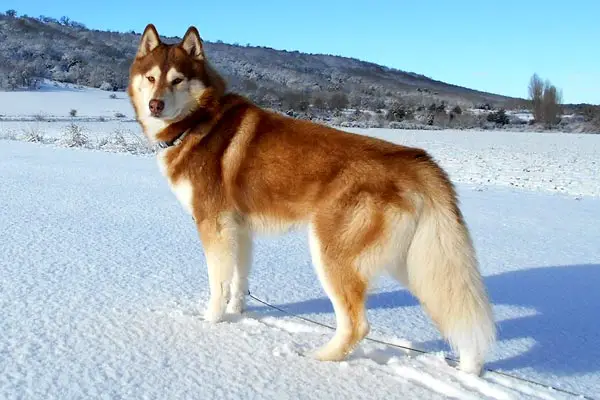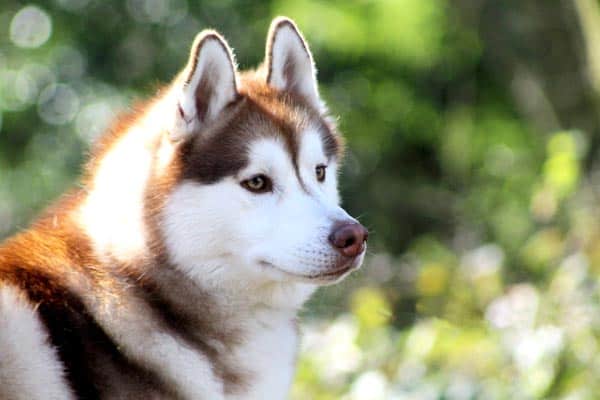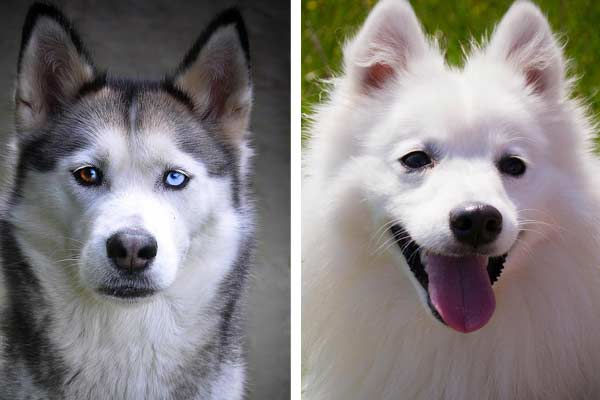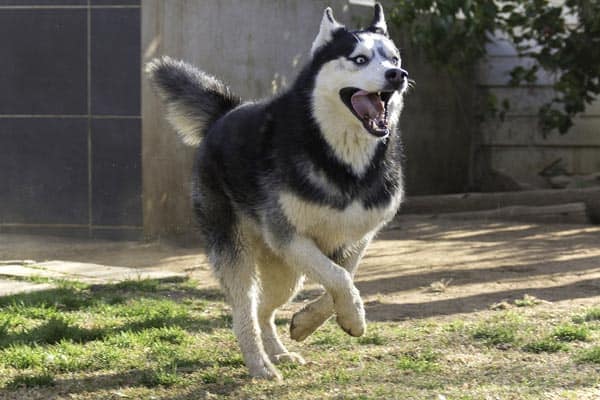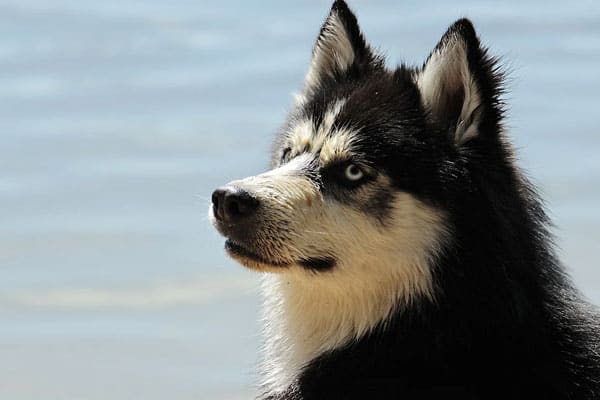Siberian Husky Colors: Learn About the Amazing Color Variety in Siberian Husky Dogs
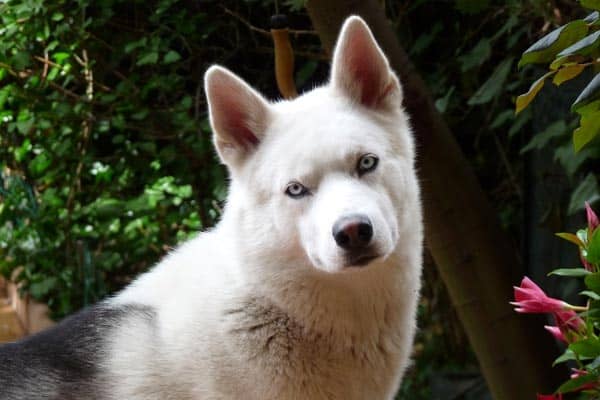
The Siberian Husky is one of those dog breeds that has become so much a part of mainstream culture, thanks in large part to a number of movies featuring the breed.
As a result, even people that don’t own dogs or even particularly like dogs can point to a Siberian Husky and name the breed accurately.
But even Siberian Husky enthusiasts often don’t realize just how many colors this dog can display. Siberian Husky colors range from pure snowy white to midnight black and the patterns and facial masks are nearly endless.
In this article, we take an in-depth look at the Siberian Husky colors – both well-known colors and little-known colors.
Siberian Husky Colors
Unlike so many purebred dog breeds today, the Siberian Husky breed standard clearly states that all coat colors are allowed. This includes pure white and all black and every color and pattern in between. It also includes any type of facial mask or pattern. This type of allowance is very rare!
See a Video Montage of the Siberian Husky Colors
This fun video montage features real Huskies from social media and labels each photo with the accompanying coat color.
While it is true that certain Siberian Husky coat colors and patterns and eye colors are more associated with this dog breed than others, there are actually a wide variety of acceptable coat colors.
This is in keeping with how most working dog breeds are bred. The breeder’s emphasis tends to favor breeding for personality and temperament traits over conforming to a certain narrow range of coat colors or patterns.
Siberian Husky Colors According to the Official Dog Breed Standard
The official American Kennel Club (AKC) dog breed standard for the purebred Siberian Husky lists the following recognized standard coat colors and patterns:
- Black.
- White.
- Agouti and white.
- Black and white.
- Sable and white.
- Red and white.
- Gray and white.
- Brown and white.
- Black, tan, and white.
The official breed standard notes the recognized markings as follows:
- Black points.
- Piebald.
What Do Sable, Agouti, and Piebald Coats Look Like in the Siberian Husky?
If you are like most dog lovers, you probably recognized the majority of the colors and markings. But then there are some that you may not be sure about.
For example, what is sable? What is agouti? What does piebald mean?
Let’s find out.
Agouti
Agouti is listed as a coat color in the breed standard. But agouti is better known as “wolf color” – it is a wild-looking coat color pattern where each individual hair is lighter in color close to the skin and gets darker near the tips.
With agouti, the predominant coat color is creme. Some hairs are banded with darker tips, producing ripple effects as the dog moves.
Sable
While sable is listed in the breed standard as a color, it is actually more like a color pattern.
Sable is defined by Husky Colors as a dog with a black nose that has reddish or brownish fur.
Piebald
The piebald marking takes its name from equines (horses). A piebald marking in a Siberian Husky is always going to be a dog with a coat that is 50+ percent white with one other color – any color – occurring in irregular patterns like spots or splotches.
More typically, the piebald coat will be at least three-quarters white, with the remaining coat occurring in patches or spots of one or more accent colors.
Exploring the Standard Coat Colors of the Siberian Husky
As Husky Colors explains, while the official AKC breed standard for the Siberian Husky specifies only major colors like red, gray, brown, black, and white, there can actually be a lot of variation within each.
So let’s take a look now at each standard coat color or pattern and what that might look like on an actual Siberian Husky dog.
White
White in a canine coat is actually the absence or suppression of color pigment in that area.
However, in a Siberian Husky, the white color may or may not be a true white, as Kiana Siberians breeder explains.
It may also take on more of a cream cast in the outer coat and be white in the undercoat. Even if a dog is considered white, other color points or tipping may still be present.
As VCA Animal Hospitals explains, when a dog has some white in the coat, this means that the dog simply is not producing any color pigment in that portion of the coat.
If the dog has an all-white coat, this means the dog is not producing color pigment for the entire coat. You might ordinarily think this would mean the dog is albino.
But an all-white coat in a Siberian Husky does not mean the dog is an albino. Albinism is a much rarer genetic condition and is caused when the dog literally does not have the gene for producing color pigment.
When the dog lacks the gene to produce color, this will affect eye and skin color as well. This is why dogs that are true full or partial albino will often have pinkish skin and blue or pink eyes, as PetMD points out.
The white-coated, blue-eyed Siberian Husky might be considered the epitome of this dog breed, but this is not an albino coloration. Rather, the white coat and blue eyes are produced through other genes expressing.
Black
Black would seem to be a fairly self-explanatory coat color in the Siberian Husky.
What many Siberian Husky lovers don’t realize is that a truly single-color or solid-color Siberian Husky coat is very rare.
Nearly all Siberian Huskies will have at least minimal amounts of second coat colors such as liver points, black points, or white patches. If the coat is close to solid black, you may still see white paws or a splash of white somewhere else on the coat.
Black as a coat color can be a dominant or a recessive color gene. When it is dominant, you will see the true, dark, midnight black coat or coat pattern with some amount of contrasting colors such as white.
When it is recessive, or dilute, the coat will take on a muted quality, and the contrasting lighter color will be more visible and may even take on a silver cast.
Red
The red coat color in a Siberian Husky can range from a deep, dark red, or copper to a very light yellow or orange.
Gray
The gray color may be darker gray or light gray. Typically the undercoat (the hair closest to the skin) is either beige or yellow.
Gray can look more matte or silvery. When the undercoat is white and the black tipping (at the ends of the hairs) is slight, this is when the coat tends to look most silver.
When the undercoat is creme or buff with dark black tipping at the ends of the hairs, this is when the coat will take on more of a matte gray tone instead.
The gray color can also be darker with more of a red/orange hue, which is sometimes called “wolf gray.”
Brown
The brown coat color in a Siberian Husky can span the gamut from a very light tan or beige all the way to deep russet.
When the brown color is quite light, it is often called the liver.
Siberian Husky Eye Colors
Just as there is an eye-popping number of coat colors and patterns for purebred Siberian Husky dogs, so too can these dogs have a surprising number of eye colors.
This is because, in addition to the two main recognized eye colors of brown and blue, the breed standard species that Siberian Huskies can have bi-color or parti-color eyes.
Blue Siberian Husky eyes
Blue is considered a relatively rare eye color in canines, but it is actually the most common eye color in the purebred Siberian Husky dog.
Siberian Husky dogs can have blue eyes no matter what genetic coat color they inherit.
Also, while blue eyes are sometimes viewed as a sign of poor genetic lines or poor health, this is a very normal and common eye color for Siberian Huskies and has no relationship to the dog’s breed lines or their overall health.
Brown Siberian Husky eyes
Brown eyes in a Siberian Husky will only occur genetically if the dog’s coat is predominantly black or all black.
Bi-color Siberian Husky eyes
A Siberian Husky with bi-color eyes will have one blue eye and one brown eye, one blue eye, and one amber eye or one brown eye, and one amber eye.
Parti-color Siberian Husky eyes
A Siberian Husky with parti-color eyes may have any amount of blue, brown, or amber in each eye. Sometimes this is called having split eyes since each eye has two or three colors instead of just one.
Parti-color eyes can sometimes appear to be hazel until you look more closely.
Multicolored eyes are caused by a genetic mutation called heterochromia.
Green or amber Siberian Husky eyes
On very rare occasions, you may see a Siberian Husky with amber or green eyes as well. The green is not a true green but rather a light shade of amber.
Often a Siberian Husky puppy will appear to have green eyes and grow up to have amber eyes, as Novel Siberian Huskies breeder points out.
Amber eyes only occur if the Siberian Husky has the genes to be red-coated to some degree.
Two Color Pigment Genes: Eumelanin and Phaeomelanin
The gene for color pigment is called melanin. The cells that produce pigment are called melanocytes.
As Dog Coat Colour Genetics explains, there are only two main color pigment genes that produce all the wide variety of coat colors and patterns you just read out.
These two-color pigment genes are called eumelanin and phaeomelanin. Nearly all dogs (albinos excepting) have some of each kind of color pigment genes in their genetic makeup.
While the principles you are about to learn are quite basic, it gets very complicated quickly because there are many other genes that can interact with the basic color genes to produce a wide range of colors and patterns on skin, eyes, nose, and coat.
Eumelanin
Eumelanin is the main color pigment gene since it codes for the color of skin, eyes, and nose as well as coat.
Eumelanin is the color pigment gene that codes for the black spectrum.
The full black spectrum can include anything from very light silver all the way through gray, blue, and black.
Phaeomelanin
Phaeomelanin is the secondary color pigment gene that codes for coat color only.
Phaeomelanin is the color pigment gene that codes for the red spectrum.
The full red spectrum can include anything from very light ivory and cream all the way through gold, orange, liver, and brown.
Is the Siberian Husky “Wolf-Colored?”
The Siberian Husky is often likened to a wild wolf because this dog does have the genes for the agouti coloration which you read about here earlier.
As you can see on the Dog Coat Colour Genetics website, the captive wild wolf in the photo looks very much like a Siberian Husky!
As National Geographic points out, out of the literally hundreds of modern domestic dog breeds in development today, the Siberian Husky is one of the very few breeds that are most closely related to wild wolves.
So it is not an accident that the Siberian Husky can appear to be visually very similar to wild wolves in both coat colors and in other features and overall build.
But under the wolf-colored coat, the Siberian Husky is very much a modern dog in every other important way.
